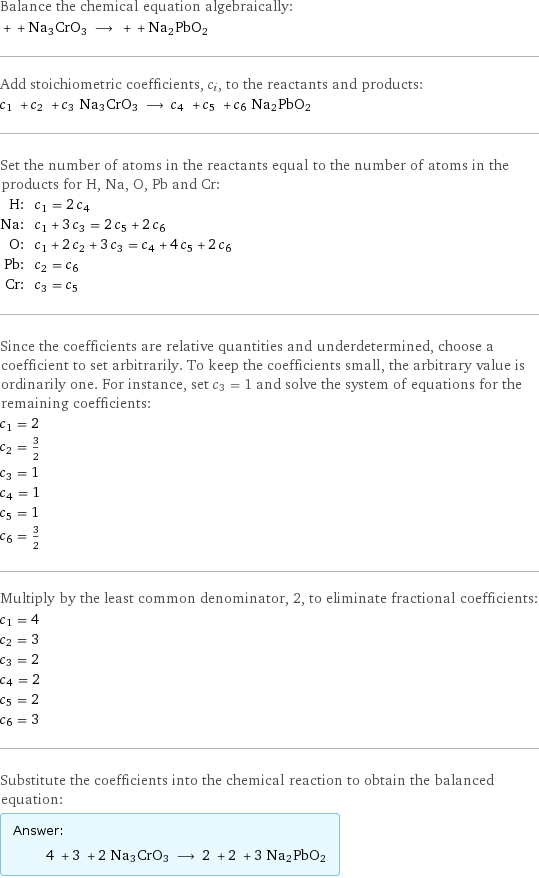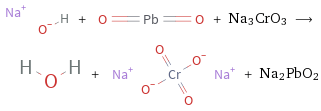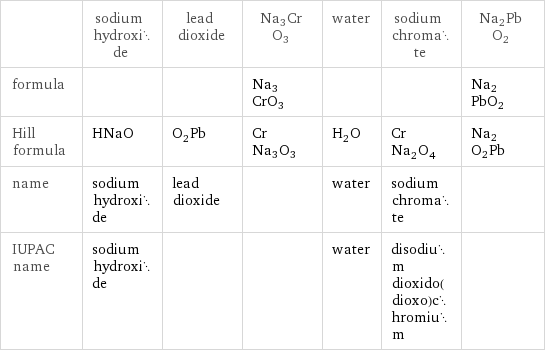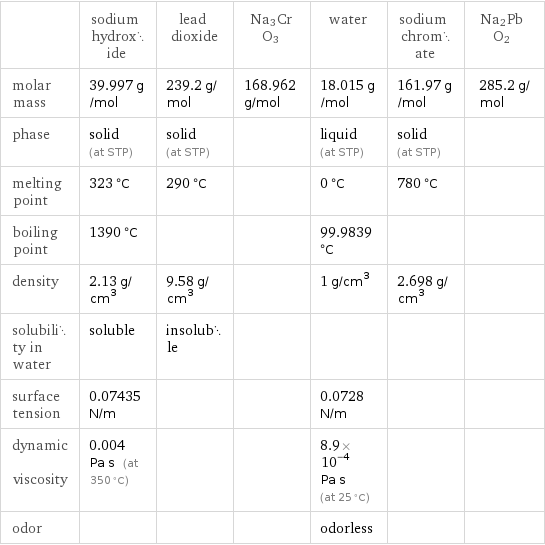Input interpretation

sodium hydroxide + lead dioxide + Na3CrO3 ⟶ water + sodium chromate + Na2PbO2
Balanced equation

Balance the chemical equation algebraically: + + Na3CrO3 ⟶ + + Na2PbO2 Add stoichiometric coefficients, c_i, to the reactants and products: c_1 + c_2 + c_3 Na3CrO3 ⟶ c_4 + c_5 + c_6 Na2PbO2 Set the number of atoms in the reactants equal to the number of atoms in the products for H, Na, O, Pb and Cr: H: | c_1 = 2 c_4 Na: | c_1 + 3 c_3 = 2 c_5 + 2 c_6 O: | c_1 + 2 c_2 + 3 c_3 = c_4 + 4 c_5 + 2 c_6 Pb: | c_2 = c_6 Cr: | c_3 = c_5 Since the coefficients are relative quantities and underdetermined, choose a coefficient to set arbitrarily. To keep the coefficients small, the arbitrary value is ordinarily one. For instance, set c_3 = 1 and solve the system of equations for the remaining coefficients: c_1 = 2 c_2 = 3/2 c_3 = 1 c_4 = 1 c_5 = 1 c_6 = 3/2 Multiply by the least common denominator, 2, to eliminate fractional coefficients: c_1 = 4 c_2 = 3 c_3 = 2 c_4 = 2 c_5 = 2 c_6 = 3 Substitute the coefficients into the chemical reaction to obtain the balanced equation: Answer: | | 4 + 3 + 2 Na3CrO3 ⟶ 2 + 2 + 3 Na2PbO2
Structures

+ + Na3CrO3 ⟶ + + Na2PbO2
Names

sodium hydroxide + lead dioxide + Na3CrO3 ⟶ water + sodium chromate + Na2PbO2
Chemical names and formulas

| sodium hydroxide | lead dioxide | Na3CrO3 | water | sodium chromate | Na2PbO2 formula | | | Na3CrO3 | | | Na2PbO2 Hill formula | HNaO | O_2Pb | CrNa3O3 | H_2O | CrNa_2O_4 | Na2O2Pb name | sodium hydroxide | lead dioxide | | water | sodium chromate | IUPAC name | sodium hydroxide | | | water | disodium dioxido(dioxo)chromium |
Substance properties

| sodium hydroxide | lead dioxide | Na3CrO3 | water | sodium chromate | Na2PbO2 molar mass | 39.997 g/mol | 239.2 g/mol | 168.962 g/mol | 18.015 g/mol | 161.97 g/mol | 285.2 g/mol phase | solid (at STP) | solid (at STP) | | liquid (at STP) | solid (at STP) | melting point | 323 °C | 290 °C | | 0 °C | 780 °C | boiling point | 1390 °C | | | 99.9839 °C | | density | 2.13 g/cm^3 | 9.58 g/cm^3 | | 1 g/cm^3 | 2.698 g/cm^3 | solubility in water | soluble | insoluble | | | | surface tension | 0.07435 N/m | | | 0.0728 N/m | | dynamic viscosity | 0.004 Pa s (at 350 °C) | | | 8.9×10^-4 Pa s (at 25 °C) | | odor | | | | odorless | |
Units
